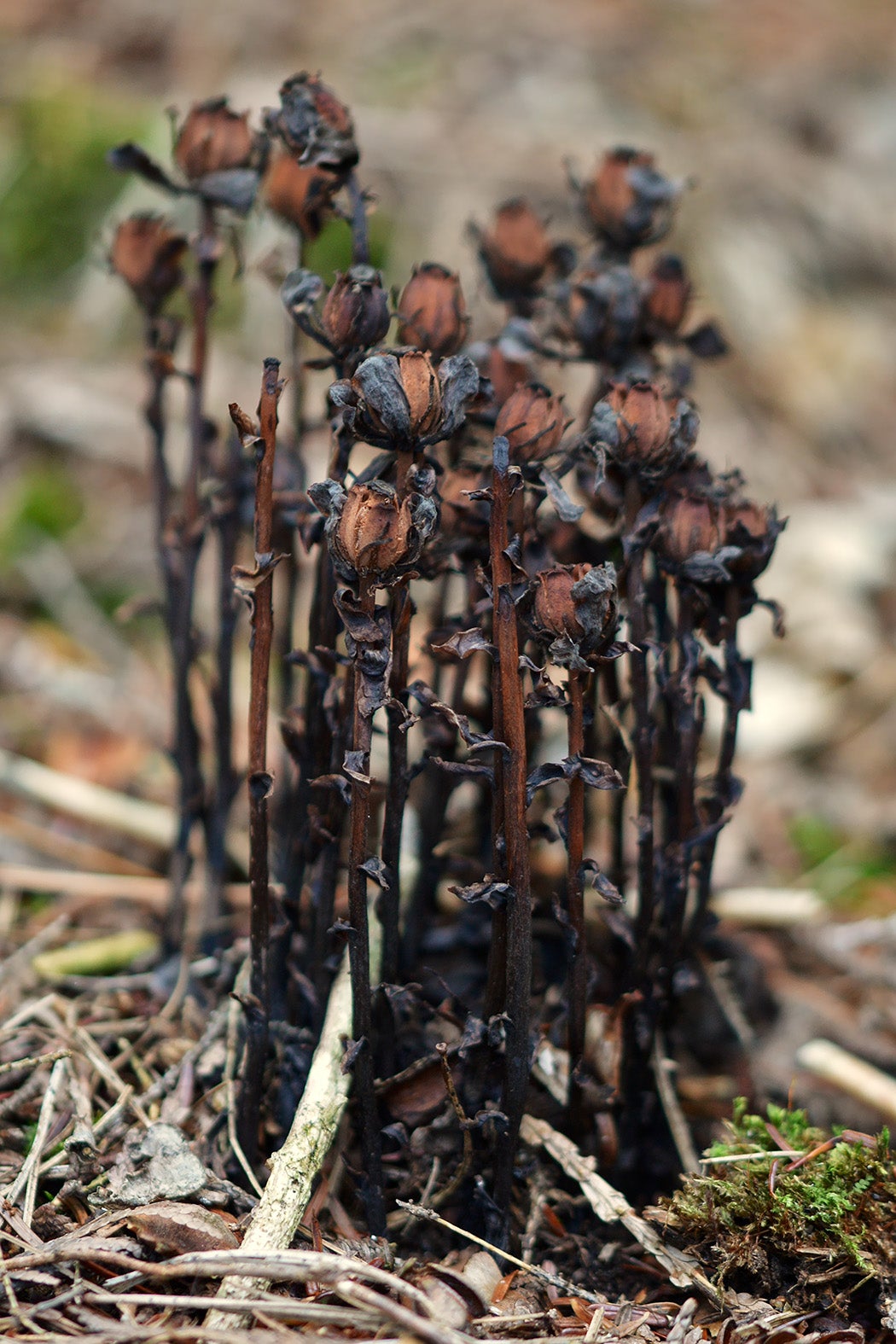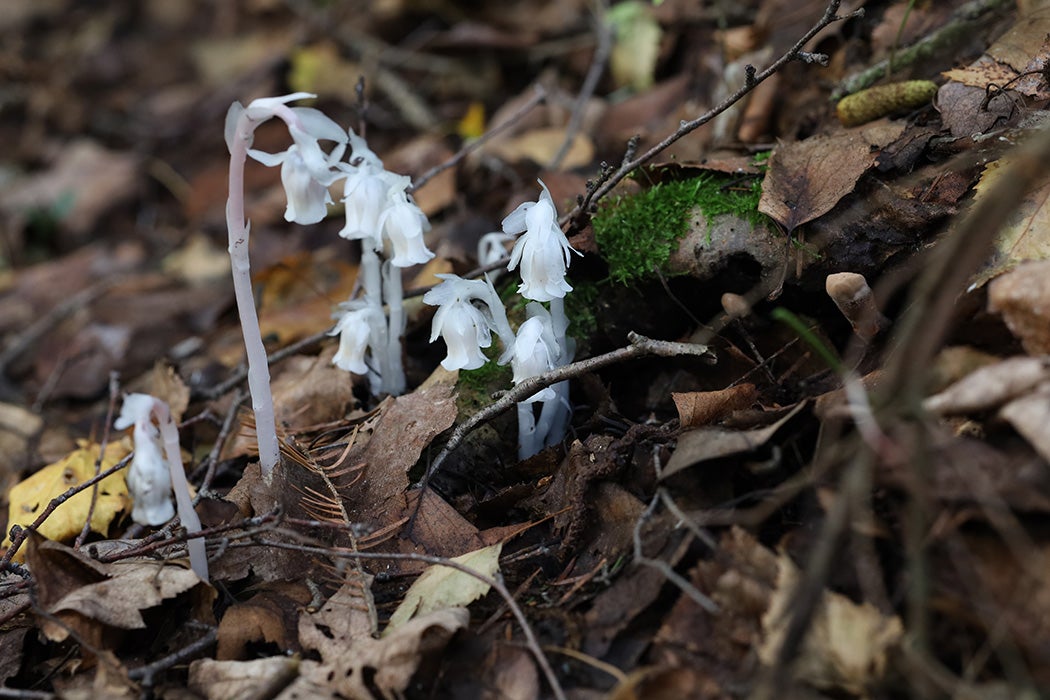Deep in the forest lies a wildflower that defies expectations. Often mistaken for a fungus, the plant is a pale, translucent white in bloom—sometimes tinted pink or, rarely, a deep red. The ephemeral flower blackens if touched and quickly decays if plucked from the earth.
This month, as we celebrate all things spooky and supernatural, it’s only fitting to spotlight a species that is both ghost and vampire: Monotropa uniflora.
This peculiar plant can be found throughout much of North America, East Asia, and in northern regions of South America. It typically grows in moist, shaded areas of mature forests, springing from the soil to flower between June and September. Each plant has only one cup-shaped flower per stem, which droops toward the ground at first bloom. This downward orientation is thought to protect its nectar and pollen from rain. Carl Linnaeus had these properties in mind when he classified the plant as Monotropa uniflora in 1753. “Monotropa” is Greek for “one turn,” a reference to the arched stem that supports the nodding flower, and “uniflora” means “one-flowered” in Latin. Once pollinated and fertilized, the flower gradually turns upright, eventually maturing into a dry, woody capsule filled with thousands of seeds.
Monotropa uniflora’s hooked appearance has also inspired its common names. “Indian pipe,” for instance, derives from the flower’s resemblance to ceremonial smoking pipes used by many North American Indigenous communities. Other common names are more closely linked to the plant’s eerie coloration, including “ghost pipe,” “ghost plant,” “corpse plant,” and “ice plant.”
Monotropa uniflora’s ghostly presence has just as much to do with what’s happening beneath the surface as above ground. Like any plant, Monotropa uniflora needs sugar to grow and reproduce. Most plants meet this need through photosynthesis, but Monotropa uniflora lacks chlorophyll, the pigment that gives plants their green color and powers the process by absorbing energy from light. It must seek sugar from another source.
The solution? Mycoheterotrophy: a form of plant nutrition in which plants obtain nourishment through networks of mycorrhizal fungi rather than photosynthesis. In this case, tiny threads of fungi in the Russulaceae family act as an underground bridge between the roots of Monotropa uniflora and those of nearby trees. The mycorrhizae deliver water and essential minerals to the trees in exchange for sugar. Monotropa uniflora takes advantage of this relationship by acting as a parasite on the fungal network, taking sugar and nutrients and giving nothing in return.

Mycoheterotrophy is a stroke of evolutionary genius. Monotropa uniflora essentially cheats the mycorrhizal fungi and trees from which it receives sustenance.
“The photosynthetic host cannot select against the mycoheterotroph without selecting against its own mutualist mycorrhizal fungi,” explain scientists Sylvia Yang and Donald H. Pfister. Additionally, because mycoheterotrophs aren’t dependent on light for photosynthesis, Monotropa uniflora can flourish in dark environments where many plants would fail.
Monotropa uniflora in Lore and Literature
All of these curious traits have made Monotropa uniflora an object of fascination for generations of storytellers. The plant is woven into oral histories and written narratives across cultures.
Cherokee storyteller Lloyd Arneach chronicles the plant’s creation as a product of human selfishness. As the legend goes, the chiefs of two quarreling nations smoked a pipe together before resolving their weeklong dispute. According to Arneach, “[The Great Spirit] decided to do something to remind all people to smoke the pipe only when making peace. So He turned them into grayish-looking flowers we now call ‘Indian Pipes’ and made them to grow wherever friends and relatives have quarreled.”

One of the most prominent storytellers to depict Monotropa uniflora was Emily Dickinson. Although widely recognized for her poetic prowess, Dickinson was also an amateur botanist. While taking botany courses at Amherst Academy and Mount Holyoke Female Seminary, she assembled more than 400 plant specimens in an herbarium that resides in Harvard’s Houghton Library today. Monotropa uniflora is among the hundreds of pressed plants that fill the book’s pages.
Plants provided constant inspiration for Dickinson’s literary works.
“Like flowers in an herbarium, the odd little poems are a faithful inventory of the natural world,” writes Barbara C. Mallonee. Monotropa uniflora is no exception, appearing in a number of Dickinson’s poems and letters. In one quatrain, she writes:
White as an Indian Pipe
Red as a Cardinal Flower
Fabulous as a Moon at Noon
February Hour—
Scholars including Yanbin Kang are working to decipher the symbolism of Monotropa uniflora in Dickinson’s poetry. The plant’s white color could represent purity. Its nodding flower could suggest humility. Its ability to thrive where other plants cannot calls to mind both strength and loneliness—qualities that might have resonated with Dickinson, who lived reclusively at her family’s homestead later in life.
In 1882, Dickinson received a painting of Monotropa uniflora from Mabel Loomis Todd, a family friend who would become the poet’s first posthumous editor. In her letter thanking Todd for the gift, Dickinson wrote “[t]hat without suspecting it you should send me the preferred flower of life, seems almost supernatural, and the sweet glee that I felt at meeting it, I could confide to none.”
Eight years later, Todd shared Dickinson’s words with the world by publishing the first collection of her poems. Todd’s illustration of the poet’s beloved “preferred flower of life” graced the front cover.
Dickinson wasn’t the only poet to pay homage to this otherworldly plant. Sylvia Plath, another Massachusetts resident with botanical interests, mentions Monotropa uniflora in her poem “Child.” She wrote this poem in January 1963, only two weeks before her death. It’s addressed to an infant discovering the world, unburdened by the darkness that casts a shadow over the narrating mother. Immersed in “the zoo of the new,” the child learns of “Indian pipe” along with “April snowdrop”—two white, nodding flowers linked with the fleeting innocence of childhood.
More recently, Christine Butterworth-McDermott’s 2019 poem “Monotropa Uniflora” plays with the plant’s simultaneous embodiment of force and fragility. The employment of bold, active language (“you feast off other hosts”) and softer expressions (“how pale! how delicate!”) reminds us of the complex nature of Monotropa uniflora’s existence. It’s both a skillful parasite and a sensitive species that begins to decompose upon separation from the fungal network that provides its nourishment.
Medicinal Benefits and Modern Use
Monotropa uniflora’s significance isn’t only poetic, it’s practical. Several Indigenous groups in North America used the plant to treat ailments including inflamed eyes, epileptic fits, and toothaches. These properties were later echoed in books on the medicinal benefits of plants. In 1887, Monotropa uniflora was even deemed “an excellent substitute for opium,” easing pain and inducing sleep.
Weekly Newsletter
Today, tinctures made with Monotropa uniflora are sold on various online platforms. Foragers have also taken to social media to share the process of gathering the plant and making tinctures of their own. Their posts often advocate responsible harvest practices, namely leaving pollinated flowers untouched and collecting only in regions where the plant is abundant. Monotropa uniflora is at risk of local extinction in states including California, Nebraska, and South Dakota. It faces increasing pressure from wild collection for medicinal use, although more research is needed to determine the scope and severity of this existential threat.
With ties to ecology, poetry, medicine, and more, the ghost of the forest has several stories to tell. If you spot Monotropa uniflora in bloom, bright against the darkness of the forest floor, take a moment to contemplate the many ways in which humans have interacted with it for centuries. This is the mission of the Dumbarton Oaks Plant Humanities Initiative: to appreciate the unparalleled significance of plants to human culture.








